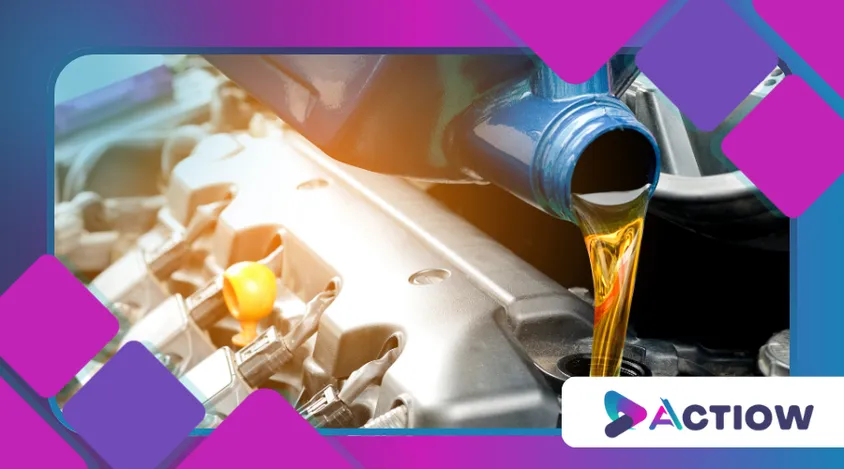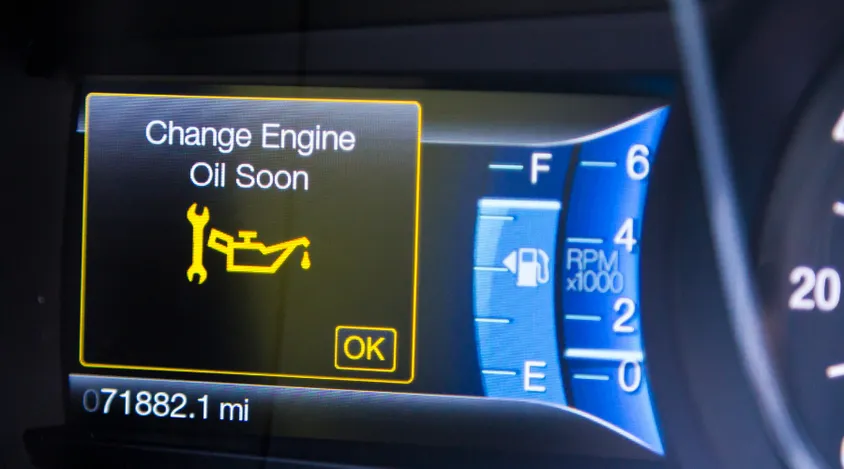Oil Change: When to Do It and Which Type to Choose?

Anúncios
Your car’s engine is its beating heart, and the oil coursing through it is its lifeblood.
Knowing when to schedule an oil change and selecting the right type of oil can make the difference between a smooth ride and a costly breakdown.
But with so many options and conflicting advice, how do you make the best choice?
Anúncios
Let’s dive into the essentials of oil changes, debunk myths, and help you keep your engine running like new.
Understanding the significance of oil changes is crucial for any car owner.
With the right knowledge, you can ensure that your vehicle remains reliable and efficient for years to come.
Why Oil Changes Matter: The Lifeline of Your Engine
Engine oil isn’t just a lubricant; it’s a multitasking marvel.
It reduces friction between moving parts, prevents overheating, and even cleans the engine by trapping dirt and debris.
Over time, however, oil breaks down, losing its effectiveness.
That’s where an oil change comes in.
Neglecting this routine maintenance can lead to reduced performance, lower fuel efficiency, and even engine failure.
Regular oil changes help maintain optimal engine performance, ensuring that all components work harmoniously.
By keeping your oil fresh, you can also extend the lifespan of your engine, saving you money in the long run.
According to a study by AAA, 35% of Americans delay or skip oil changes, risking costly repairs that could average $4,000 or more.
Don’t let your car become a statistic.
When Should You Change Your Oil?
Gone are the days of the rigid “every 3,000 miles” rule.
Modern vehicles and advanced synthetic oils have extended intervals, but the answer isn’t one-size-fits-all.
Here’s how to determine the right timing for your car:
1. Follow the Manufacturer’s Recommendations
Your owner’s manual is your best friend.
Most manufacturers recommend an oil change every 7,500 to 10,000 miles for newer models.
However, this can vary based on driving conditions and oil type.
Being aware of your specific vehicle’s needs can help you maintain optimal performance over time.
For instance, some manufacturers offer guidelines tailored to different driving styles and environments, which can be beneficial.
2. Monitor Your Driving Habits
Frequent short trips, stop-and-go traffic, or towing heavy loads can accelerate oil degradation.
If your driving falls into the “severe” category, you may need to change your oil more often.
Keeping a log of your driving habits can provide insight into when your oil might need changing.
This proactive approach can help you stay ahead of potential issues and maintain your vehicle’s health.
3. Check the Oil Life Monitor
Many modern cars come equipped with an oil life monitoring system that calculates when an oil change is needed based on driving conditions and engine performance.
Trust the tech—it’s smarter than you think.
These systems use algorithms to analyze your driving patterns, providing a more accurate indication of when service is needed.
Relying on these advanced features can help you avoid unnecessary oil changes while ensuring timely maintenance.
4. Inspect the Oil Yourself
Old-school methods still work.
Use the dipstick to check the oil’s color and consistency.
If it’s dark, gritty, or smells burnt, it’s time for a change.
Regularly checking your oil can empower you to catch potential issues before they escalate.
Additionally, understanding the state of your oil can help you gauge the overall health of your engine.

Which Type of Oil Should You Choose?
Choosing the right oil isn’t just about picking a brand off the shelf.
It’s about understanding your car’s needs and the unique benefits of each oil type.
Here’s a breakdown:
1. Conventional Oil
The most basic option, conventional oil is derived from crude oil and is suitable for older vehicles with simple engine designs.
It’s affordable but requires more frequent changes.
For many drivers, conventional oil may be sufficient, especially for those who drive less frequently or in mild conditions.
However, it’s essential to monitor the oil condition regularly to ensure optimal performance.
+ How to Wash Your Car Properly Without Scratching the Paint
2. Synthetic Oil
Engineered for performance, synthetic oil offers superior protection, especially in extreme temperatures.
It lasts longer and improves fuel efficiency, making it ideal for modern engines.
Investing in synthetic oil can lead to better engine performance and reduced wear and tear over time.
Additionally, synthetic oils often contain additives that help keep the engine clean, further enhancing longevity.
3. Synthetic Blend
A mix of conventional and synthetic oils, this option provides better performance than conventional oil at a lower cost than full synthetic.
It’s a good middle ground for SUVs and trucks.
Synthetic blends can offer enhanced protection without the higher price tag, making them a popular choice for many drivers.
This option can be particularly beneficial for those who frequently drive in varying conditions, as it balances cost and performance.
4. High-Mileage Oil
Designed for vehicles with over 75,000 miles, high-mileage oil contains additives that reduce leaks and minimize wear on aging engines.
Using high-mileage oil can help maintain engine health as your vehicle ages.
These oils are formulated to address the unique challenges faced by older engines, such as increased oil consumption and seal wear.
For drivers with aging vehicles, this option can be a smart investment in maintaining performance and reliability.
The Great Debate: Synthetic vs. Conventional Oil
The choice between synthetic and conventional oil often sparks heated debates.
Here’s a quick comparison to help you decide:
| Feature | Synthetic Oil | Conventional Oil |
|---|---|---|
| Cost | Higher | Lower |
| Lifespan | 7,500–10,000 miles | 3,000–5,000 miles |
| Performance | Better in extreme temperatures | Adequate for normal conditions |
| Engine Protection | Superior | Basic |
While synthetic oil is more expensive upfront, its extended lifespan and enhanced protection can save you money in the long run.
Understanding your driving conditions and engine requirements can help you make an informed decision.
For example, if you frequently drive in extreme temperatures or engage in heavy towing, synthetic oil may be worth the investment.

DIY vs. Professional Oil Changes: Which Is Better?
Changing your oil can be a satisfying DIY project, but it’s not for everyone.
Here’s a look at the pros and cons of each approach:
DIY Oil Changes
- Pros: Saves money, gives you control over the oil and filter used, and can be done at your convenience.
- Cons: Requires tools, time, and proper disposal of used oil. Mistakes can lead to engine damage.
Taking on a DIY oil change can be rewarding, especially if you enjoy working on your vehicle.
However, it’s crucial to follow safety protocols and ensure that you have the necessary tools and knowledge to do it correctly.
Professional Oil Changes
- Pros: Quick, convenient, and performed by trained technicians. Many shops offer inspections and top-offs of other fluids.
- Cons: More expensive, and quality can vary depending on the service provider.
Choosing a reputable shop can ensure that your oil change is done correctly and efficiently.
Many shops also provide additional services, such as fluid checks and tire rotations, which can add value to your visit.
++ Preventive Maintenance: What to Do Every 10,000 km?
How Often Should You Change the Oil Filter?
The oil filter plays a crucial role in trapping contaminants, but it’s often overlooked.
A good rule of thumb is to replace the filter with every oil change.
However, some high-quality filters can last through two oil changes.
Check your owner’s manual for specific recommendations.
Understanding the importance of the oil filter can help you maintain your engine’s health.
A clean filter allows for better oil flow, which is essential for optimal engine performance.
Common Myths About Oil Changes
Let’s bust some myths that might be clouding your judgment:
- Myth: You Must Change Oil Every 3,000 Miles
- Reality: Modern oils and engines can go much longer. Follow your manufacturer’s guidelines.
- Myth: Synthetic Oil Causes Leaks
- Reality: High-quality synthetic oils are safe for most engines and won’t cause leaks.
- Myth: All Oils Are the Same
- Reality: Oils vary widely in composition and performance. Choose one that matches your car’s needs.
Being aware of these myths can help you make informed decisions about your vehicle’s maintenance.
Staying educated about oil types and maintenance practices will empower you to keep your engine running smoothly.
The Environmental Impact of Oil Changes
Used motor oil is a significant environmental hazard if not disposed of properly.
Just one gallon of used oil can contaminate one million gallons of water.
Always recycle your used oil at designated collection centers.
Many auto shops offer this service for free.
Understanding the environmental implications of oil changes can motivate you to take responsible actions.
By recycling your oil, you contribute to a healthier planet while ensuring compliance with local regulations.
Tables: Oil Change Intervals and Costs
| Vehicle Type | Recommended Interval | Average Cost |
|---|---|---|
| Sedan (Conventional) | 5,000 miles | $35–$75 |
| SUV (Synthetic Blend) | 7,500 miles | $50–$90 |
| Sports Car (Full Synthetic) | 10,000 miles | $70–$120 |
| Oil Type | Pros | Cons |
|---|---|---|
| Conventional | Affordable, widely available | Shorter lifespan, less protection |
| Synthetic | Long-lasting, high performance | More expensive |
| Synthetic Blend | Balanced cost and performance | Not as durable as full synthetic |
| High-Mileage | Protects older engines | Only for high-mileage vehicles |
Understanding the costs associated with different vehicle types and oil options can help you budget for maintenance.
Being proactive about oil changes can prevent costly repairs and enhance your vehicle’s performance.
The Future of Oil Changes: What’s Next?
As electric vehicles (EVs) gain popularity, the need for traditional oil changes may decline.
However, for the millions of internal combustion engines still on the road, oil changes remain a critical maintenance task.
Innovations like longer-lasting synthetic oils and eco-friendly formulations are shaping the future of this essential service.
Staying informed about advancements in oil technology will help you make the best choices for your vehicle.
As the automotive landscape evolves, understanding these changes can prepare you for future maintenance needs.
Conclusion: Making the Right Choice for Your Car
An oil change is more than just routine maintenance—it’s an investment in your car’s longevity and performance.
By understanding when to change your oil and which type to choose, you can save money, avoid costly repairs, and enjoy a smoother driving experience.
Whether you’re a DIY enthusiast or prefer leaving it to the pros, the key is to stay informed and proactive.
Your car’s engine deserves nothing less.
So, the next time you hear that little voice reminding you about an oil change, don’t ignore it.
Your car will thank you.
By addressing the when, why, and how of oil changes, this guide aims to empower you with the knowledge to make the best decisions for your vehicle.
After all, a well-maintained car isn’t just a mode of transportation—it’s a reflection of your care and attention.
Keep it running smoothly, and it will take you places, mile after mile.
